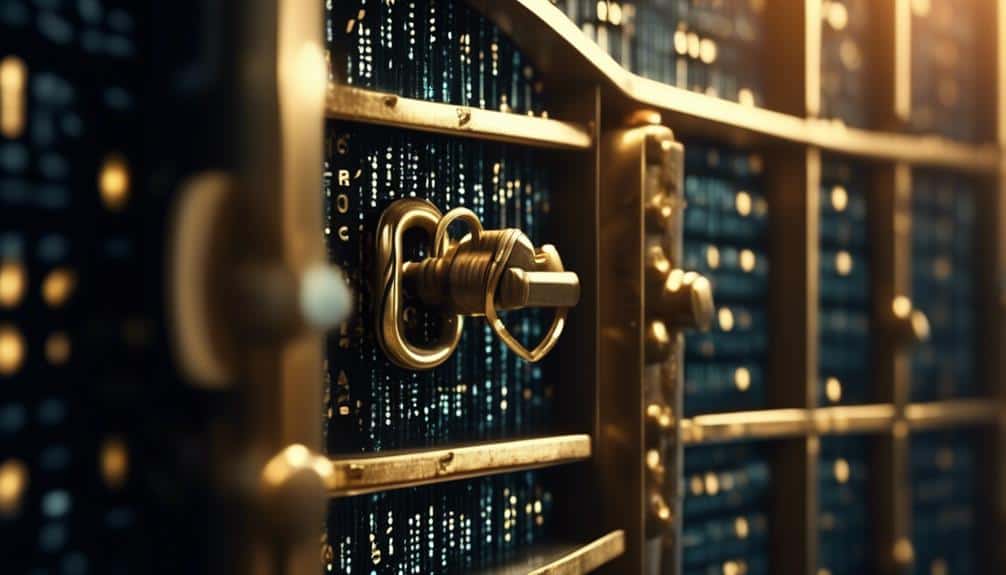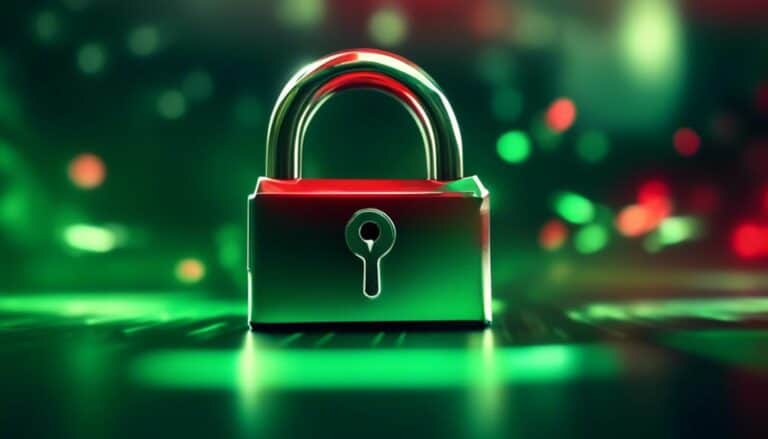Quick Guide: Implementing Ironclad Protection for Your Digital Domain
Are you tired of constantly worrying about the safety of your digital domain? Look no further! In this quick guide, we will show you how to implement ironclad protection that will put your mind at ease.
From assessing your current security measures to encrypting your data, we have you covered.
So, if you're ready to take control of your digital security and safeguard your valuable information, keep reading to discover the secrets to a fortified digital fortress.
Key Takeaways
- Assess digital security vulnerabilities and prioritize them based on impact and likelihood.
- Strengthen passwords by using a combination of characters, avoiding common patterns, and implementing two-factor authentication.
- Implement multi-factor authentication to add an extra layer of security and protect accounts from unauthorized access.
- Secure network connections through network segmentation, intrusion detection systems, strong authentication methods, encryption protocols, and regular updates and patches for network devices.
- Encrypt data to ensure confidentiality and integrity, comply with regulations, protect data during transmission and storage, and reduce the risk of data breaches.
- Understand different encryption methods, choose appropriate techniques for cloud storage protection, and manage encryption keys effectively.
- Follow regular software updates and patch management processes to maintain security and integrity, address vulnerabilities, and prevent unauthorized access, data theft, or disruptions.
- Keep all software, including operating systems and applications, up to date to close security gaps, apply the latest security enhancements, and maintain a secure digital environment.
Assessing Your Digital Security

Assess the strength of your digital security measures to ensure robust protection for your digital domain. In today's interconnected world, it's crucial to stay vigilant and proactive against potential threats. Evaluating vulnerabilities and conducting risk assessments are essential steps in fortifying your defenses.
To begin, identify potential weaknesses in your digital infrastructure. This includes analyzing your network architecture, software applications, and hardware devices. Look for outdated systems, unpatched software, or misconfigured settings that could leave your digital domain susceptible to attacks.
Next, prioritize your vulnerabilities based on their potential impact and likelihood of exploitation. This will help you allocate resources effectively and address the most critical risks first. Conducting a risk assessment also involves assessing the value of your digital assets and the potential consequences of a breach.
Additionally, consider external factors that could impact your digital security, such as third-party vendors or cloud service providers. Ensure that they adhere to robust security practices and regularly review their compliance.
Strengthening Your Passwords
To fortify your defenses even further, it's imperative to strengthen your passwords with robust and secure practices. Inadequate passwords can leave your digital domain vulnerable to cyber threats. Here are some crucial steps to enhance your password management and improve password strength:
- Use a combination of characters: Create passwords that include a mix of uppercase letters, lowercase letters, numbers, and symbols. This makes it harder for hackers to guess or crack your password.
- Avoid common and predictable patterns: Steer clear of using easily guessable passwords like 'password123' or sequential patterns like '123456'. Opt for unique and unpredictable combinations.
- Implement two-factor authentication: Enable two-factor authentication whenever possible. This adds an additional layer of security by requiring a second verification step, such as a text message code or fingerprint scan.
- Regularly update your passwords: Change your passwords periodically, especially for critical accounts. This ensures that even if your password is compromised, the impact will be limited.
- Use a reliable password manager: Consider using a password manager to securely store and generate complex passwords. This eliminates the need to remember multiple passwords while keeping them safe.
Implementing Multi-Factor Authentication

Strengthen your digital defenses by implementing multi-factor authentication, a crucial step in safeguarding your accounts from unauthorized access.
Multi-factor authentication (MFA) adds an extra layer of security by requiring users to provide multiple forms of identification before gaining access to their accounts. This ensures that even if one authentication factor is compromised, the account remains protected.
One effective method of implementing MFA is by integrating biometric authentication. Biometric factors, such as fingerprints or facial recognition, provide a unique and secure way to verify your identity. By using biometric authentication, you can add an additional layer of protection that's difficult for attackers to replicate.
Managing authentication tokens is another important aspect of MFA implementation. Authentication tokens are generated and provided to users when they successfully authenticate themselves. These tokens serve as temporary credentials, granting access to the account for a limited time. It's crucial to securely store and manage these tokens, ensuring that they aren't easily accessible to unauthorized individuals.
Securing Your Network Connections
To fortify your digital defenses, ensure the security of your network connections by implementing robust measures. Safeguarding your network connections is crucial in protecting your digital domain from potential threats. Here are five essential steps you can take to secure your network connections:
- Network Segmentation: Divide your network into smaller, isolated segments to limit the potential impact of a breach. This way, if one segment is compromised, the entire network won't be at risk.
- Intrusion Detection: Deploy intrusion detection systems (IDS) to monitor network traffic and detect any suspicious activity or potential threats. IDS can help identify unauthorized access attempts and provide early warning signs of a security breach.
- Implement Strong Authentication: Enforce the use of strong passwords and multi-factor authentication (MFA) for accessing your network. MFA adds an extra layer of security by requiring users to provide multiple forms of identification, such as a password and a fingerprint scan.
- Encrypt Network Traffic: Utilize encryption protocols, such as SSL/TLS, to secure your network traffic. Encryption ensures that the information transmitted between devices is unreadable to unauthorized parties.
- Regularly Update and Patch Network Devices: Keep your network devices up to date with the latest firmware and security patches. Regular updates and patches help address any vulnerabilities and protect against known exploits.
Encrypting Your Data

Now it's time to ensure the utmost security for your valuable data by encrypting it.
Encryption is of utmost importance as it scrambles your data in a way that only authorized parties can access it.
There are various encryption methods available, such as symmetric and asymmetric encryption, each with its own strengths and weaknesses.
Importance of Encryption
Encryption is a critical safeguard for protecting the confidentiality and integrity of your data in the digital realm. It ensures that your information remains secure and inaccessible to unauthorized individuals. Here are some key benefits of encryption and best practices for its implementation:
- Data confidentiality: Encryption ensures that only authorized parties can access the encrypted data, keeping it safe from prying eyes.
- Data integrity: Encryption provides a way to verify the integrity of your data, ensuring that it hasn't been tampered with during transmission or storage.
- Compliance with regulations: Encryption helps organizations comply with data protection regulations and industry standards.
- Secure communication: Encrypting your data before transmitting it over the internet protects it from interception and unauthorized access.
- Protection against data breaches: Encryption significantly reduces the risk of data breaches, as encrypted data is useless without the encryption key.
Encryption Methods Explained
As we move into the realm of encryption methods, it is imperative to understand the various techniques available to safeguard your data. Encryption is the process of converting plain text into cipher text, making it unreadable to unauthorized individuals. There are several advanced encryption algorithms that can be used to protect your digital domain. These algorithms ensure a high level of security by employing complex mathematical functions and key management systems. When it comes to encryption for cloud storage, it is essential to choose a method that not only protects your data while it's being transmitted but also when it's stored in the cloud. Some popular encryption methods for cloud storage include AES (Advanced Encryption Standard), RSA (Rivest-Shamir-Adleman), and Blowfish. Take a look at the table below for a quick comparison of these encryption methods:
| Encryption Method | Key Size | Security Level |
|---|---|---|
| AES | 128, 192, 256 bits | High |
| RSA | 2048, 3072, 4096 bits | Very High |
| Blowfish | 32 to 448 bits | Moderate |
Securing Encrypted Data
To ensure the utmost security for your encrypted data, employ robust security measures that protect against unauthorized access and maintain the confidentiality of your sensitive information. Here are some key steps to secure your encrypted data:
- Use strong encryption algorithms: Implement encryption algorithms that are widely accepted and known for their strength, such as AES (Advanced Encryption Standard) or RSA (Rivest-Shamir-Adleman).
- Manage encryption keys carefully: Protect your encryption keys with strong passwords and store them in secure locations to prevent unauthorized access.
- Implement secure communication channels: Use protocols like SSL/TLS to ensure secure transmission of encrypted data over networks.
- Regularly update encryption software: Stay up-to-date with the latest versions of encryption software to benefit from the latest security patches and enhancements.
- Perform regular security audits: Conduct periodic audits to identify and address any vulnerabilities in your encryption systems.
Regularly Updating and Patching Software

Regularly updating and patching software is essential for maintaining the security and integrity of your digital domain. With the constant evolution of technology, software vulnerabilities are discovered on a regular basis. These vulnerabilities can be exploited by malicious actors to gain unauthorized access to your systems, steal sensitive data, or disrupt your operations. To counter these threats, software developers release security patches that address the identified vulnerabilities.
By regularly updating your software with the latest security patches, you ensure that any known vulnerabilities are promptly addressed, reducing the risk of exploitation. These patches typically contain fixes for specific security issues and are designed to strengthen the security of your software. Neglecting to apply these updates leaves your systems exposed to potential attacks.
To stay protected, it's important to establish a robust patch management process. This involves regularly monitoring for software updates and promptly applying them across your digital infrastructure. Automated tools can help streamline this process, ensuring that updates are applied consistently and in a timely manner.
In addition to applying security patches, it's also crucial to keep all software up to date. This includes operating systems, browsers, plugins, and other applications. Regularly checking for updates and installing them promptly helps close any security gaps and ensures that you're benefiting from the latest security enhancements.
Frequently Asked Questions
How Can I Determine the Effectiveness of My Current Digital Security Measures?
To evaluate the effectiveness of your current digital security measures, measure the strength of your passwords, assess the encryption methods used, and regularly monitor and update your systems to ensure maximum protection.
Are There Any Specific Requirements or Best Practices for Creating Strong Passwords?
To create strong passwords, make sure they are unique and avoid using common phrases or personal information. Utilize password management tools to generate and store complex passwords securely. Stay vigilant in protecting your digital domain.
What Are the Most Common Types of Multi-Factor Authentication Methods?
To implement ironclad protection for your digital domain, consider using biometric authentication or time-based one-time password (TOTP) methods. These are the most common types of multi-factor authentication that add an extra layer of security.
How Can I Ensure the Security of My Wi-Fi Network at Home?
To ensure the security of your home Wi-Fi network, prioritize two things. First, enable Wi-Fi network encryption using WPA2 or WPA3. Second, strengthen router security by changing the default password and keeping it updated.
Is There Any Difference Between Encrypting Data Stored on a Local Device Versus Data Stored in the Cloud?
Encrypting data stored on a local device and data stored in the cloud are different. Cloud encryption protects data as it travels and rests in the cloud, while local storage encryption safeguards data on a specific device.
Conclusion
In conclusion, implementing ironclad protection for your digital domain is crucial for safeguarding your sensitive information. Assessing your digital security, strengthening passwords, implementing multi-factor authentication, securing network connections, encrypting data, and regularly updating software are essential measures to ensure the highest level of protection.
By following these steps diligently, you can mitigate the risk of cyber threats and maintain the integrity of your digital domain. Stay vigilant and prioritize the security of your digital assets.








